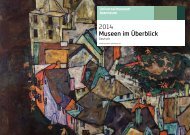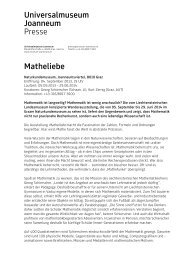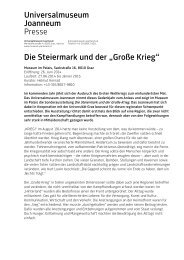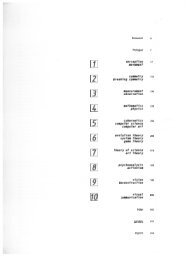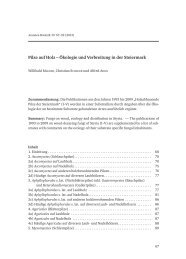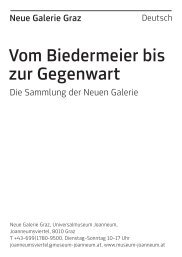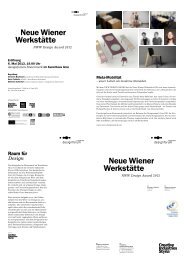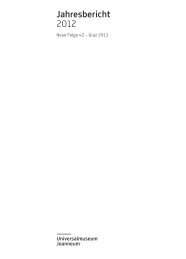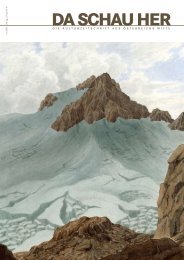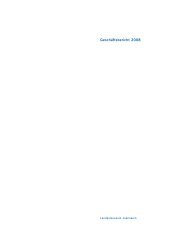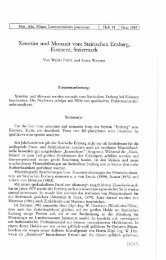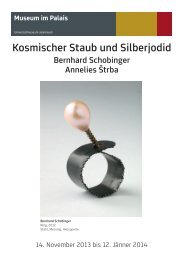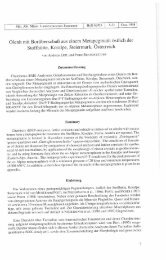Diana Thater gorillagorillagorilla - Universalmuseum Joanneum
Diana Thater gorillagorillagorilla - Universalmuseum Joanneum
Diana Thater gorillagorillagorilla - Universalmuseum Joanneum
Erfolgreiche ePaper selbst erstellen
Machen Sie aus Ihren PDF Publikationen ein blätterbares Flipbook mit unserer einzigartigen Google optimierten e-Paper Software.
Nahaufnahmen ein. Die 150-jährige Geschichte medialer Repräsentation<br />
von Gorillas ist durchdrungen von Angst, Begehren und<br />
Ekel. <strong>Thater</strong>s Installation hebt diese Geschichte auf, indem sie ihr<br />
Bilder fundamentaler Schönheit entgegensetzt. Die Ästhetik der<br />
verschiedenen Arten Films – etwa der Gegensatz von körnigem<br />
Super 8 und scharfem 16 mm – kreiert einen verlockenden Bilderfluss,<br />
der den Betrachter provoziert, Gedächtnis und Gefühle<br />
stimuliert, Erinnerungen an alte Familienvideos wachruft und an<br />
modernes Nachrichtenmaterial denken lässt. Es zeigt sich hier,<br />
wie stark <strong>Thater</strong>s Arbeit von dem tragischen Niedergang unserer<br />
Natur geprägt ist, von dem Fortschreiten illegaler Abholzung und<br />
dem Aussterben jener Tiere, die in dieser Umwelt leben.<br />
Wie <strong>Diana</strong> <strong>Thater</strong> formuliert:<br />
„Ich möchte die Natur nicht als kontemplativ und beruhigend<br />
darstellen; sie soll erhaben und Furcht einflößend sein. Es geht<br />
mir nicht um den für das 19. Jahrhundert typischen Schrecken,<br />
wo die Natur gähnend weit, unendlich gefährlich ist und den<br />
Menschen zu verschlingen droht. Es geht mir um ein Bild der<br />
Natur, das dem 21. Jahrhundert entspricht – wie ein toter oder<br />
sterbender Körper, den wir getötet haben und der somit verloren<br />
ist. Und das ist Furcht erregend.”7<br />
Indem <strong>Thater</strong> die Technik hinter dem projizierten Bild preisgibt,<br />
stört sie jede Neigung zu einer selig machenden Versenkung<br />
in die Natur. Dadurch soll sich dem Betrachter einprägen, dass<br />
unser Bild der Natur konstruiert und maschinell bearbeitet ist –<br />
was vor allem auf die kulturell präjudizierte Wahrnehmung von<br />
Gorillas zutrifft. Der Konflikt zwischen Natur und Kultur ist insbesondere<br />
ein Schlüsselthema in <strong>Thater</strong>s früheren Arbeiten. Im<br />
Laufe der Jahre hat sich ihr Werk von der Repräsentation trainierter<br />
Tiere hin zu wilden Tieren entwickelt. Die Installation<br />
Electric Mind (1996), die sich mit Aspekten von Sprache und<br />
Bewusstsein auseinandersetzte, zeigte noch einen Schimpansen<br />
in Gefangenschaft. Die Arbeit basiert auf Pat Murphys Kurzgeschichte<br />
Rachel in Love (1987), in welcher die Seele eines toten<br />
jungen Mädchens in die Psyche eines Schimpansen verpflanzt<br />
wird. Das tote und das lebende Wesen entwickeln sich gemeinsam.<br />
Stimmgebung und Körpersprache sind dergestalt miteinander<br />
verschränkt, dass eine Art visuelles Vokabular entsteht.<br />
Eine der ersten Arbeiten, für die <strong>Thater</strong> Tiere in freier Natur filmte,<br />
war Delphine (1999). Die Installation zeigt Delfine in ihrem natürlichen<br />
Lebensraum. Mit der Hilfe des Delfinschützers Richard<br />
O’Barry filmte <strong>Thater</strong> diese intelligenten Säugetiere beim Schwimmen<br />
im Ozean, wobei die Kamera es den Delfinen gleichtut und<br />
Bergit Arends 50 51<br />
overturns 150 years of deep anxiety. The aesthetics<br />
of the different film types – the grainy Super 8 or the<br />
sharp 16 mm – create a tantalizing flow of imagery,<br />
provoking and stimulating viewers with memories<br />
and feelings of their own, conjuring old family videos<br />
or modern news footage. Her work is deeply imbued<br />
with the tragic demise of nature, the progression of<br />
illegal deforestation and the extinction of the animals<br />
that live within this habitat.<br />
As <strong>Diana</strong> <strong>Thater</strong> says:<br />
“I don’t want nature to be contemplative and reassuring,<br />
but sublime and terrifying. Not terrifying in that<br />
nineteenth-century way, where it is yawning wide, end -<br />
lessly dangerous and devouring, but in that twentyfirst<br />
century way – like a dead or dying body because<br />
we’ve killed it and it is gone. And that is terrifying.”7<br />
<strong>Thater</strong> reveals the machinery behind the projected<br />
image and thereby disturbs the beatific contemplation<br />
of nature. She seeks to imprint on the viewer that our<br />
image of nature is constructed and machined – particularly<br />
pertinent for the culturally prejudiced perception<br />
of gorillas. In <strong>Thater</strong>’s previous works, the conflict<br />
between nature and culture is a key theme. Over the<br />
years, her work has progressed from representing<br />
trained animals to wild animals. Electric Mind (1996)<br />
dealt with questions of languages and consciousness,<br />
and showed a chimpanzee filmed in captivity. It was<br />
based on the short story Rachel in Love (1987), where<br />
the mind of the dead young girl is grafted into the<br />
mind of a chimpanzee. They co-evolve, the dead and<br />
the living. Vocalisation and body movements fold into<br />
one another and become a visual vocabulary.<br />
However, in Delphine (1999) <strong>Thater</strong> filmed dolphins<br />
in their natural habitat. The installation became one<br />
of the first works in which she filmed animals in the<br />
wild. With the help of dolphin rights activist Richard<br />
O’Barry, <strong>Thater</strong> filmed these intelligent mammals<br />
swimming the ocean, the cameras gurgling into and<br />
above the water as dolphins do. This work conflates<br />
with her work as an animal activist, working against<br />
the captivity and slaughter of dolphins. And even<br />
though the subject of the installation is the freedom<br />
of the dolphins roaming and playing, it is underlined



